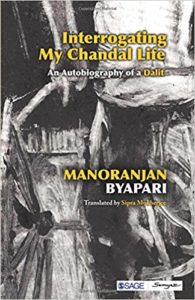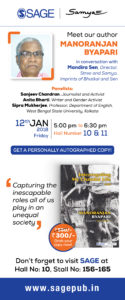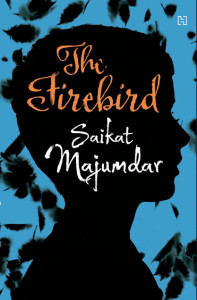“Interrogating My Chandal Life: An Autobiography of a Dalit” by Manoranjan Byapari
 Manoranjan Byapari’s Interrogating My Chandal Life: An Autobiography of a Dalit is about the author documenting his life from life in East Pakistan to moving to India. When he arrived in India with his family he lived in Shiromanipur refugee camp. They try and make a life for themselves in Bengal but they lived in abject poverty and unable to feed themselves regularly. They were also at a social disadvantage for being Dalits. To escape these straitened circumstances Manoranjan Byapari ran away from home as a teenager in search of work. He got caught in the 1970s Naxalite movement in Calcutta. He was imprisoned. It was while in prison as a twenty four year old that he learned to how to read and write.
Manoranjan Byapari’s Interrogating My Chandal Life: An Autobiography of a Dalit is about the author documenting his life from life in East Pakistan to moving to India. When he arrived in India with his family he lived in Shiromanipur refugee camp. They try and make a life for themselves in Bengal but they lived in abject poverty and unable to feed themselves regularly. They were also at a social disadvantage for being Dalits. To escape these straitened circumstances Manoranjan Byapari ran away from home as a teenager in search of work. He got caught in the 1970s Naxalite movement in Calcutta. He was imprisoned. It was while in prison as a twenty four year old that he learned to how to read and write.
So from 1977 till 1981, my time was spent reading Katha literatures, folk literatures, translated literatures, travelogues, religious books. Some praised my dedication to books, some taunted me. I ‘bypassed’ all. None of their words many impact on me.
Once released he still had to earn his bread and butter, so began pulling a rickshaw. He would inevitably carry a book to read while waiting for passengers. One day he was parked outside the college where Mahashweta Devi taught. She emerged and sought a rickshaw and it happened to be Manoranjan Byapari. He had to quickly put aside the book he was reading — Agnigarba ( The Fire Womb).
A collection of short stories where every character was a known and familiar face to me. Every story had at its centre a protagonist who was a labouring man, who was a representative of the protest of that class, who was unwilling to accept defeat and who fought till death, then rose again to continue the fight. I had a particular affection for this author. Having been once accidentally drawn into the Naxalite movement, I had spent much time with them and heard the story of the martyred Brati, a character in her novel Hajar Chaurasir Ma ( The Mother of 1084). This book had endeared the writer to the Naxalites, who spoke of her as a maternal figure to them. Engrossed in reading, I suddenly awoke to the fact that my turn at the rickshaw line had come. The familiar figure of a teacher whom we all knew by sight stepped out of the college and approached us.
As luck would have it, the passenger was none other than Mahashweta Devi. Manoranjan Byapari still had not a clue  but it was during the course of the journey that he asked her the meaning of a word he had read in the book — jijibisha ( the will to live) and struck up a conversation. Mahashweta Devi was impressed at how he had taught himself to read while incarcerated in Presidency Jail under the tutelage of mastermashai. She asked him to contribute to her journal “where working people like you write”. Just as she was leaving she gave him her address, to the shocked amazement of Manoranjan Byapari. He could not believe it that his passenger was the famous writer Mahashweta Devi.
but it was during the course of the journey that he asked her the meaning of a word he had read in the book — jijibisha ( the will to live) and struck up a conversation. Mahashweta Devi was impressed at how he had taught himself to read while incarcerated in Presidency Jail under the tutelage of mastermashai. She asked him to contribute to her journal “where working people like you write”. Just as she was leaving she gave him her address, to the shocked amazement of Manoranjan Byapari. He could not believe it that his passenger was the famous writer Mahashweta Devi.
The rest they say is history. Mahashweta Devi gave him his writing break. Since then he has published many novels, short stories, essays, and his autobiography, of two volumes, the first volume which has been translated and published by Sage-Samya. He has won the Anaya Samman given by the television channel 24 Ghanta, 2013, and the Suprabha Majumdar Smarak Puraskar of the Bangla Akademi of West Bengali in 2014.
In January 2018 he was invited to attend the World Book Fair (WBF) held in New Delhi and the Jaipur Literature Festival. At the WBF he was in conversation with Sanjeev Chandan*, journalist, author and social activist, and Anita Bharti**, teacher, writer and Dalit rights activist.
At the Jaipur Literature Festival 2018, Manoranjan Byapari was on a panel “Dr. Ambedkar and his Legacy” along with Chintan Chandrachud, Christophe Jaffrelot, and Sukhadeo Thorat. They were in conversation with Pragya Tiwari.
According to the translator, Sipra Mukherjee,
Byapari’s prose is urban and modern. Translating the language used by Byapari, therefore, did nto pose the many problems that are often faced when translating Dalit literature, where the language embodies its marginalization palpably in the earthiness of its dialect which cannot be kept in translation, which tends to be standard English. His prose is often driven more by action than by emotions. . . .
The English translation is shorter than 25,000-30,000 words than the original Bengali version but this has been done with the concurrence of the writer.
Now Manoranjan Byapari is so well-known as a writer that he shares an anecdote that happened in Hyderabad.
Once on an invitation I journeyed to the University of Hyderabad. I boarded an autorickshaw from the station, bound for the University Guest House. The driver of the auto was educated and well-informed. Upon hearing that I was from Calcutta, he wanted to know if I had heard of this writer from my city who drives a rickshaw, has never been to school, but who writes books.
Read an extract from the autobiography on making a bomb.
Interrogating my Chandal Life will undoubtedly be a significant book in the landscape of Dalit literature. This despite the storytelling being written with a flourish that can prove to be fairly distracting with its verbosity. It is much like the writer himself who when speaking on a public forum is full of wisdom and fascinating insights but ever the performer— perhaps some of it has seeped into the written word too. Nevertheless read this seminal book for the history of Bengal and the plight of dalits it charts through Manoranjan Byapari’s testimony.
Update ( 3 Sept 2018): Manoranjan Byapari has signed a multi-book deal with Westland, an Amazon company. The figures have not been revealed but one of the translators working on the project is eminent Bengali translator Arunava Sinha. ( “Former rickshaw-puller inks big book deal“, TOI, 2 Sept 2018)
Manoranjan Byapari Interrogating my Chandal Life: An Autobiography of a Dalit ( Translated by Sipra Mukherjee) SAGE Samya, New Delhi, 2018. Pb. pp. Rs 550
*Sanjeev Chandan is Editor of the leading feminist magazine Streekaal and founder of Marginalised Publications, an independent publisher that publishes Dalit-Bahujan literature and academic works on cultural and political issues. Formerly, Mr. Chandan was Hindi Editor at Forward Press, a bilingual magazine that looks at issues and interests from a Dalit-Bahujan perspective. His collection of stories, 546veen Seat ke Stree, was published recently.
**Anita Bharti is an author, a teacher and a well-known critic of Dalit literature. One of her important contributions is the book Samkaleen Nariwaad aur Dalit Stree ka Pratirodh, which received the ‘Savitribai Phule Vaichariki Samman’ award from Streekaal magazine in 2016. Another important work is the collection of poetry that she has edited – Yathastithi se Takraate Hue Dalit Stree Jeewan se Judi Kavitaayein. Ms. Bharti has been honoured with several awards, which include the Indira Gandhi Shikshak Samman and Delhi Rajya Shikshak Samman.
1 May 2018



